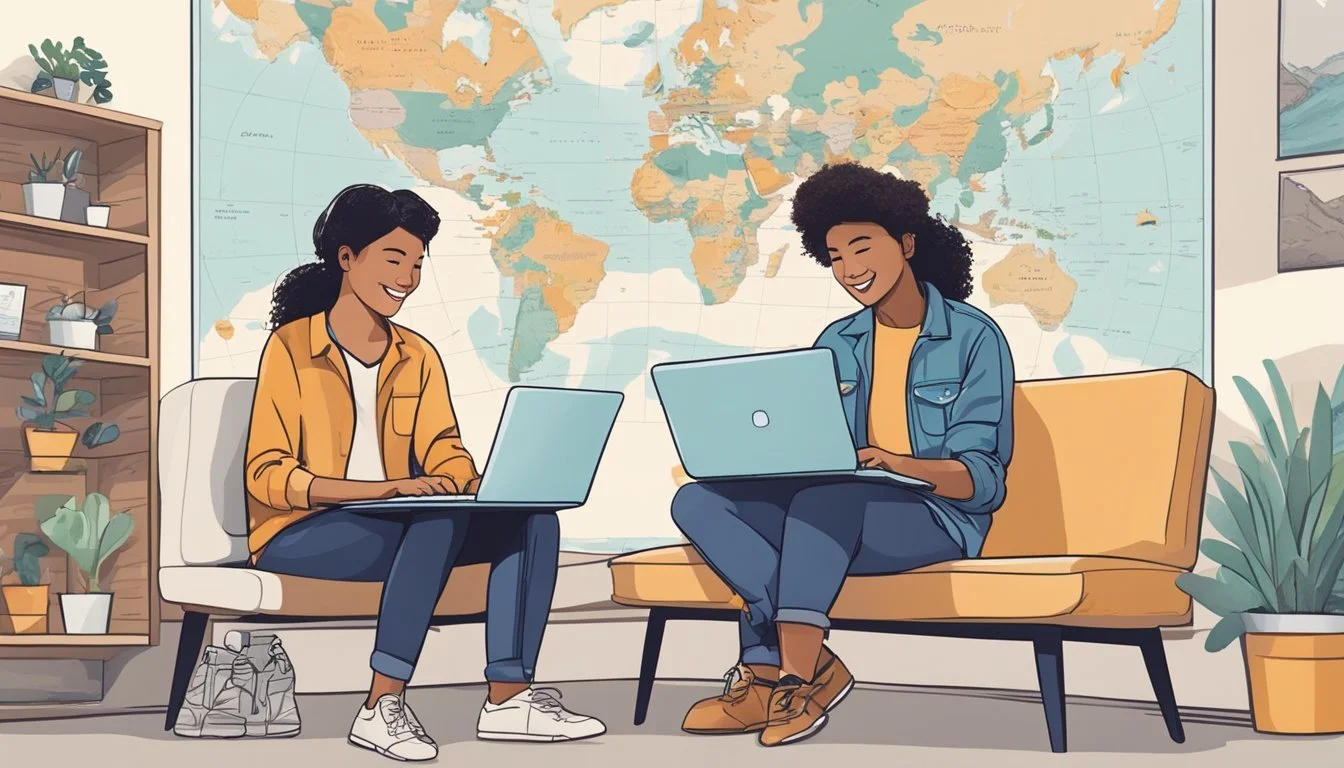6 Strategies for Maintaining Long-Distance Friendships
Tips for Lasting Connections
Friendship can face unique challenges when separated by distance, but many people find ways to keep their bonds strong. These connections often require a bit more effort and creativity to maintain, given the lack of physical presence that local friendships enjoy.
Understanding and implementing strategies for maintaining long-distance friendships can be invaluable for preserving these meaningful relationships. People often wonder how to stay close when circumstances change, and this article aims to provide clear, actionable solutions to help navigate these transitions.
1) Regular Video Calls
Regular video calls can be an effective way to stay connected with friends who live far away. Unlike text messages or phone calls, video chats allow for face-to-face interaction, which can make conversations feel more personal and engaging.
Scheduling these calls at consistent intervals, such as weekly or bi-weekly, helps maintain a sense of routine and normalcy. Both parties can look forward to the set times, enhancing their commitment to the friendship.
Video calls also enable friends to share visual elements of their lives. They might show each other their living spaces, pets, or even special moments, creating a stronger connection. This can be particularly valuable in keeping the friendship vibrant and meaningful.
Using platforms like Zoom, Skype, or FaceTime can make arranging video calls simple and accessible. Ensuring a stable internet connection and a quiet environment further improves the quality of these interactions.
Additionally, incorporating activities like watching movies together or playing online games during video calls can add a fun and interactive dimension to the conversation. This not only keeps the interaction lively but also strengthens the bond between friends.
2) Plan Visits in Advance
Planning visits well in advance can significantly strengthen long-distance friendships. By organizing trips ahead of time, both parties can ensure their schedules align, and they have sufficient time to prepare.
Advanced planning allows friends to find convenient dates, look for affordable travel options, and set aside resources for the visit. It also provides something exciting to look forward to.
During these visits, friends can engage in shared activities, explore new places, and create lasting memories together. Setting expectations and discussing plans can make the trip more enjoyable and fulfilling.
Regularly planning such visits fosters anticipation and reinforces the bond, making the periods between meetings more bearable. It creates a tangible connection point and reaffirms the commitment to maintaining the friendship over time and distance.
By committing to these visits, friends prioritize their relationship in a way that transcends the limitations imposed by physical distance.
3) Virtual Game Nights
Virtual game nights offer an excellent opportunity to bond with long-distance friends. They bring an element of fun and excitement while fostering connection. All that’s needed is an internet connection and a video conferencing app like Zoom or Skype.
There are various games that can be easily adapted for virtual play. Online Jeopardy allows friends to compete in a familiar and friendly environment. It's as simple as sharing your screen and using templates available online.
Another engaging option is “Hunt A Killer,” a murder mystery game. This game provides monthly clues, making it a long-term activity that keeps friends engaged over time.
For more relaxed gatherings, sharing a recipe or food theme adds a unique twist. Everyone can prepare and enjoy the same appetizer or dish while playing, enhancing the shared experience. This small effort can make the evening feel more cohesive and enjoyable.
These game nights bring a sense of togetherness that can help maintain the closeness of friendships despite physical distances.
4) Share Photos and Memories
Sharing photos and memories helps keep the connection alive. When friends live far apart, visual reminders of past experiences can bridge the gap. They can evoke shared emotions and strengthen the bond.
Regularly exchanging photos of daily life can make a significant difference. It provides insight into each other's routines and surroundings. Even mundane moments, like a meal or a walk, can be meaningful.
Creating shared photo albums is another effective approach. Platforms like Google Photos or Facebook Groups allow friends to add pictures and comment on them. This creates a dedicated space for preserving and celebrating memories.
Revisiting old photos brings back nostalgia and joy. Sharing these moments can spark conversations about the good times and reinforce the friendship. It also shows that both friends value their shared history.
Sending physical photos or personalized items, like photo books, can be a thoughtful gesture. These tangible items often carry more emotional weight and can be cherished for years. This method provides a more personal touch.
By sharing visual moments, friends can maintain a sense of presence in each other's lives, despite the distance. It is an approach that combines technology and personal effort to keep the friendship strong.
For more ideas on maintaining long-distance friendships, check out this guide.
5) Read the Same Book
Reading the same book can be a great way to maintain a long-distance friendship. It gives both friends shared content to discuss and explore.
Start by selecting a book that interests both parties. This can be a novel, a non-fiction title, or even a collection of short stories.
Once the book is chosen, set a reading schedule. Agree on chapters to read weekly or bi-weekly.
Having regular discussions about the book adds another layer to the relationship. It creates opportunities for deeper conversation and intellectual bonding.
Use video chats, messaging apps, or book club platforms to discuss the book. This keeps communication open and consistent.
Reading together also introduces new topics and ideas into the friendship, keeping it fresh and engaging.
Choosing different genres over time can add variety. For more tips on maintaining long-distance friendships, check out this guide.
Reading the same book can make geographical distances feel less significant. It's an effective way to stay connected emotionally and intellectually.
6) Send Care Packages
Sending care packages helps maintain long-distance friendships by showing thoughtfulness and attention. A well-curated package reflects the recipient's interests and needs, making them feel valued. By including items that remind them of home or shared memories, the impact becomes even more meaningful.
Personalized notes can make a significant difference. Whether it's a birthday card or a quick message, handwritten notes add a personal touch.
Practical gifts such as cafe gift cards or snacks can be included. These items add a layer of practicality and pleasure. A virtual coffee date can be enhanced with a Starbucks gift card, making the conversation feel more intimate.
Another idea is to send theme-based packages. A Spooky Halloween Care Package is an example, including fun and festive items that align with shared interests or upcoming holidays. This keeps the friendship fun and engaging.
Ultimately, the intention behind the care package matters most. The thought, effort, and genuine care in each item will be appreciated, reinforcing the connection despite the distance.
Understanding the Importance of Long-Distance Friendships
Maintaining long-distance friendships offers significant emotional benefits and creates robust social support systems that are essential for personal growth and resilience.
Emotional Benefits
Long-distance friendships contribute to emotional well-being by providing a sense of consistency and stability. These relationships often deepen because of the intentional effort required to maintain them. They become a source of comfort in times of stress or change. Hearing a familiar voice or receiving a thoughtful message can uplift spirits and provide necessary reassurance.
The emotional support from someone who knows your history and struggles can be profoundly grounding. It helps reduce feelings of loneliness and increases happiness. Regular communication, whether through calls or messages, ensures that emotional bonds remain strong, even when physical presence is not possible.
Social Support Systems
Long-distance friendships act as essential social support systems that offer practical advice, empathy, and encouragement. They can provide unique perspectives and solutions to problems due to their geographical and cultural diversity. This network is crucial in challenging times, offering a reliable support base that can be leaned on.
Such friendships help in building resilience and coping mechanisms. The trust and understanding developed over time ensure that you can share your worries without judgment. Efficient use of technology, such as video calls and social media, enhances these relationships, making it easier to stay connected and maintain a robust support system.
Understanding the importance of these facets helps in valuing and prioritizing long-distance friendships. The benefits they bring are indispensable, enriching lives in meaningful and lasting ways.
Effective Communication Techniques
Effective communication is vital for sustaining any long-distance friendship. Key strategies include selecting appropriate tools for communication and establishing clear boundaries to respect each other's time and availability.
Choosing the Right Tools
Selecting the best communication tools can make interactions seamless and engaging. Video calls via platforms like Zoom or Skype allow friends to see facial expressions, adding a personal touch. Instant messaging applications such as WhatsApp or Facebook Messenger offer quick and frequent text updates. For those who enjoy longer, thoughtful messages, email remains a valuable option. Additionally, platforms like Marco Polo offer the flexibility of asynchronous video messaging, which can be more convenient for friends in different time zones.
Each tool has its advantages. Video calls are suitable for deep, meaningful conversations, while instant messaging provides quick check-ins. Utilizing a mix of these tools caters to different needs and preferences, making communication more effective and less monotonous.
Setting Communication Boundaries
Establishing boundaries is crucial to ensuring that communication remains respectful and manageable. Friends must discuss and agree on suitable times for calls and messages, considering time zone differences and personal schedules. This helps to avoid interruptions during work or personal time.
It’s helpful to set expectations about response times. For example, agreeing that it's acceptable to respond within 24 hours can reduce pressure and prevent misunderstandings. Friends should also be upfront about their preferred modes of communication for different types of updates or emergencies. Recognizing each other's limits and discussing these boundaries openly fosters a healthier, more sustainable long-distance friendship.
Overcoming Challenges in Long-Distance Friendships
Maintaining long-distance friendships can be tricky. Key challenges include handling miscommunications and dealing with time zone differences, both of which require proactive strategies.
Handling Miscommunications
Miscommunications often arise due to text-based conversations lacking visual or vocal cues. To mitigate this, it's essential to clarify ambiguous messages promptly. Friends should avoid assuming tone or intent and ask questions for better context.
Using video calls can significantly reduce misunderstandings compared to text messages. It allows for facial expressions and voice inflections to come through, making communication clearer.
Additionally, establish agreed-upon norms for discussing sensitive topics, such as choosing specific times when both parties are relaxed and attentive. Practicing active listening, where each person repeats back what they think they heard, can also help ensure mutual understanding.
Dealing with Time Zone Differences
Time zone differences can make scheduling conversations challenging. To overcome this, friends can use shared online calendars to find overlapping free times. This ensures that when one person is available, the other is not overwhelmed with work or sleep schedules.
Flexibility and advance planning are crucial. Scheduling regular catch-ups at mutually convenient times helps maintain consistency in communication. It’s also helpful to leave messages or voice notes that the other can respond to at their convenience.
Utilizing asynchronous communication methods like emails or apps where message threads are maintained can bridge the gap created by different time zones. This approach keeps the conversation ongoing even if real-time chats are infrequent.






